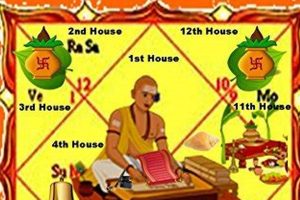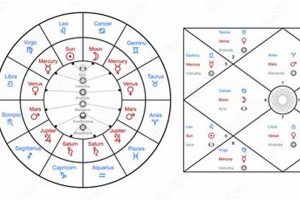Software applications employing generative pre-trained transformer models are now being applied to the domain of Jyotia, also known as Indian or Hindu astrology. These programs leverage vast datasets of astrological texts and charts to provide insights, predictions, and interpretations related to planetary positions and their influence on human lives. An example of this technology’s application includes generating personalized birth chart readings or providing predictions based on planetary transits.
This technological integration can potentially democratize access to complex astrological calculations and interpretations, previously requiring years of specialized study. By automating these processes, such software can offer quicker and potentially more consistent analysis. Furthermore, the integration of large language models may facilitate research within the field by enabling scholars to analyze large volumes of historical astrological data, identify patterns, and potentially refine traditional interpretive methodologies. This development builds upon a long tradition of using computational tools in astrology, from ancient astronomical calculations to modern astrological software.
This exploration will further examine the technical underpinnings, practical applications, ethical considerations, and potential impact of this emerging technology on the practice and study of Jyotia.
Tips for Utilizing Jyotia Software
These tips provide guidance for using software applications that apply generative pre-trained transformer models to Jyotia. These suggestions aim to maximize the benefits while mitigating potential drawbacks.
Tip 1: Understand the Limitations. While these programs can offer valuable insights, they should not be considered replacements for consultation with experienced astrologers. Software relies on algorithms and data; human interpretation accounts for nuances and individual circumstances that algorithms might overlook.
Tip 2: Verify Information. Cross-reference the information generated by the software with established astrological texts and principles. This ensures the accuracy of interpretations and fosters a deeper understanding of the underlying concepts.
Tip 3: Focus on Self-Reflection. Utilize the software’s output as a starting point for self-reflection and personal growth, rather than relying on it for definitive answers or predictions. Jyotia can be a powerful tool for self-discovery when approached with thoughtful introspection.
Tip 4: Explore Different Software Options. Various programs offer different features, methodologies, and levels of complexity. Explore multiple options to find the software that best suits individual needs and preferences.
Tip 5: Maintain a Critical Perspective. Approach generated interpretations with a healthy dose of skepticism. Blind faith in any software can lead to misinterpretations and potentially harmful decisions.
Tip 6: Respect Ethical Considerations. Be mindful of the ethical implications of using such software, including data privacy and the potential for misuse of astrological information. Responsible usage promotes trust and maintains the integrity of Jyotia.
By following these guidelines, individuals can harness the potential of Jyotia software effectively and responsibly, promoting self-awareness and informed decision-making.
By understanding the capabilities and limitations of this technology, one can integrate these tools into the broader context of Jyotia’s rich tradition and philosophical underpinnings.
1. Automated Chart Generation
Automated chart generation represents a significant advancement within Vedic Astrology facilitated by generative pre-trained transformer models. Traditionally, creating a Vedic astrological chart required intricate calculations based on time, date, and location of birth. This process, often performed manually or with basic calculators, demanded considerable expertise and time. Generative pre-trained transformer models automate these computations, dramatically reducing the time and effort needed for chart creation. This automation allows practitioners to focus on interpretation and analysis rather than complex calculations. Consider, for example, an astrologer needing to generate numerous charts for clients in a short timeframe. Automated chart generation provides efficiency, ensuring accurate charts are readily available.
This automation has broader implications beyond individual practitioners. Research utilizing large datasets of astrological charts becomes significantly more feasible. Imagine investigating the prevalence of particular planetary combinations across different demographics. Automated chart generation allows researchers to compile and analyze thousands of charts quickly, potentially revealing statistically significant patterns. This capability can lead to new understandings within Vedic Astrology, refining traditional interpretations and perhaps unveiling previously unknown correlations. Furthermore, this accessibility expands opportunities for learning and exploration within Vedic Astrology. Individuals interested in exploring their birth charts can now readily access accurate charts without requiring specialized knowledge of complex calculations, thus fostering wider engagement with this ancient practice.
The ability to generate charts accurately and efficiently, coupled with the analytical power of these models, positions automated chart generation as a foundational component of modern Vedic Astrology. While the automation streamlines the technical aspects, it underscores the importance of skilled interpretation. The generated chart serves as a starting point for deeper analysis, requiring nuanced understanding of astrological principles to extract meaningful insights. This development, therefore, empowers practitioners and researchers alike, enabling them to delve further into the complexities and subtleties of Vedic Astrology.
2. Prediction Refinement
Prediction refinement represents a core functionality within Vedic Astrology GPT, leveraging the analytical capabilities of generative pre-trained transformer models to enhance the accuracy and nuance of astrological forecasts. Traditional predictive methods often rely on established interpretations of planetary transits and combinations, sometimes lacking the precision afforded by analyzing vast datasets. Generative pre-trained transformer models, trained on extensive astrological data, offer the potential to refine these predictions by identifying subtle patterns and correlations previously overlooked.
- Data-Driven Insights
Generative pre-trained transformer models can analyze vast datasets of astrological charts and historical events, identifying correlations between planetary placements and life outcomes. For example, the software could analyze the charts of individuals who experienced significant career advancements and identify recurring planetary patterns associated with such events. These data-driven insights can refine predictions by providing statistical probabilities associated with specific planetary configurations, moving beyond generalized interpretations toward more personalized and statistically informed forecasts.
- Transit Analysis Refinement
Predicting the effects of planetary transits often involves considering the transit’s influence on the individual’s natal chart. Generative pre-trained transformer models can analyze historical data related to specific transits, refining predictions by incorporating how these transits have manifested in similar natal chart configurations in the past. For instance, the software might analyze historical data on the effects of Jupiter transiting through a particular house to refine predictions for individuals currently experiencing this transit, taking into account the nuances of their specific natal chart placements.
- Personalized Predictions
Traditional predictive methods often provide generalized interpretations for specific planetary transits or combinations. Generative pre-trained transformer models, by considering the individual’s entire natal chart in conjunction with current transits, can personalize predictions by incorporating the unique interplay of planetary influences within their chart. This personalized approach can yield more specific and relevant insights, moving beyond generic interpretations toward tailored predictions.
- Continuous Refinement
As more data becomes available and the models are further trained, the predictive accuracy of the software has the potential to continuously improve. This ongoing refinement allows the software to adapt and evolve, incorporating new astrological knowledge and insights. For instance, as new research emerges on the influence of specific planetary combinations, this information can be incorporated into the model’s training data, further refining its predictive capabilities.
Prediction refinement through Vedic Astrology GPT represents a significant shift towards data-driven and personalized astrological forecasting. By leveraging the analytical power of these models, practitioners can access more nuanced and statistically informed predictions, enhancing their ability to provide insightful guidance. This data-driven approach also opens up new avenues for research, potentially leading to a deeper understanding of the complex interplay of planetary influences on human lives.
3. Personalized Readings
Personalized readings represent a significant application of generative pre-trained transformer models within Vedic Astrology. Traditionally, obtaining a personalized reading required consultation with an experienced astrologer, often involving significant time and expense. Integrating these models into software applications offers the potential to democratize access to personalized astrological insights, making them more readily available to a wider audience.
- Birth Chart Interpretation
Generative pre-trained transformer models can analyze an individual’s birth chart, providing detailed interpretations of planetary placements, house influences, and significant astrological combinations. For example, the software could analyze the placement of Venus in the seventh house and offer insights into the individual’s approach to relationships and partnerships. This automated interpretation provides a comprehensive overview of the individual’s astrological profile, serving as a foundation for deeper self-exploration.
- Personalized Predictions
Beyond static birth chart interpretation, these models can generate personalized predictions based on current planetary transits and their interaction with the individual’s natal chart. For instance, the software might analyze the impact of an upcoming Saturn transit on an individual’s career, providing insights into potential challenges and opportunities. This personalized predictive capability empowers individuals to navigate life events with greater awareness.
- Remedial Measures
Vedic Astrology often incorporates remedial measures to mitigate potential negative influences. Software integrating generative pre-trained transformer models can suggest personalized remedies based on the individual’s birth chart and current planetary transits. This could include recommendations for specific mantras, gemstones, or rituals. This feature offers personalized guidance for navigating challenges and enhancing positive influences.
- Accessibility and Affordability
Personalized astrological readings, traditionally requiring consultations with experienced astrologers, can be expensive and geographically limited. Software applications utilizing these models increase accessibility and affordability, enabling individuals to access personalized insights regardless of location or financial constraints. This democratization expands the potential reach of Vedic Astrology, making its wisdom more widely available.
Personalized readings generated through Vedic Astrology GPT software offer a powerful tool for self-discovery and informed decision-making. While these automated interpretations provide valuable insights, they should complement, not replace, consultations with experienced astrologers who can provide nuanced guidance and address complex situations. The accessibility offered by these applications empowers individuals to explore their astrological profile, navigate life events with greater awareness, and engage with Vedic Astrology’s rich tradition in a more personalized and accessible manner. This integration of technology and tradition offers a new paradigm for understanding and applying the principles of Vedic Astrology in the modern world.
4. Accessibility Enhancement
Accessibility enhancement is a crucial aspect of integrating generative pre-trained transformer models into Vedic Astrology. Traditionally, accessing quality astrological information required considerable resources, including locating qualified practitioners, scheduling consultations, and often incurring significant expense. This limited access based on geographic location, financial resources, and availability of qualified professionals. Vedic Astrology GPT applications offer the potential to overcome these barriers, democratizing access to astrological insights and empowering individuals to explore this ancient practice more readily.
- Reduced Financial Barriers
Traditional consultations with astrologers can be costly, creating a financial barrier for many individuals seeking astrological guidance. Software applications, often available through subscription models or one-time purchases, offer a more affordable alternative. This reduced financial burden allows a wider range of individuals to access personalized readings and astrological insights, fostering greater inclusivity within the practice.
- Overcoming Geographical Limitations
Finding qualified Vedic astrologers can be challenging, particularly for individuals living in areas with limited access to such practitioners. Online software applications transcend geographical boundaries, allowing anyone with an internet connection to access astrological resources and personalized readings, regardless of location. This global accessibility expands the reach of Vedic Astrology, connecting individuals with relevant information and guidance irrespective of their physical location.
- 24/7 Availability
Traditional consultations require scheduling appointments, often subject to the astrologer’s availability. Software applications provide 24/7 access to astrological information, enabling individuals to explore their birth charts, receive personalized readings, and access predictive insights at their convenience. This on-demand availability empowers users to engage with Vedic Astrology on their own terms, enhancing flexibility and convenience.
- Empowerment Through Information
By providing accessible and personalized astrological insights, these applications empower individuals to take ownership of their astrological journey. Users can explore their birth charts in detail, understand the influences of planetary transits, and explore potential remedial measures. This readily available information promotes self-awareness and encourages informed decision-making, aligning with the core principles of Vedic Astrology.
Enhanced accessibility through Vedic Astrology GPT applications represents a paradigm shift in how individuals can engage with this ancient practice. By reducing financial and geographical barriers, these applications promote greater inclusivity and empower individuals to explore Vedic Astrologys wisdom on their own terms. While software applications offer valuable insights, they should be viewed as tools that complement, not replace, the expertise and nuanced guidance provided by experienced astrologers. This combination of technological accessibility and traditional wisdom offers a powerful pathway for individuals seeking to deepen their understanding of themselves and the universe through the lens of Vedic Astrology.
5. Research Facilitation
Research facilitation within Vedic Astrology is significantly enhanced through generative pre-trained transformer models. These models offer tools to analyze large datasets of astrological charts and historical information, opening new avenues for research previously impractical due to the time and resources required for manual data processing. This capability fosters a data-driven approach to understanding astrological principles, potentially validating traditional interpretations and uncovering new correlations between planetary positions and life events. For instance, researchers could investigate the statistical prevalence of specific planetary combinations among individuals achieving notable success in particular fields. Such analysis could refine existing interpretations of these combinations, providing empirically supported insights into their influence. Another potential research area involves analyzing historical data to correlate planetary transits with significant societal events, potentially deepening our understanding of mundane astrology.
The application of these models also extends to the analysis of ancient astrological texts. Researchers can leverage natural language processing capabilities to identify recurring themes, interpret complex symbolism, and potentially uncover lost or obscured knowledge embedded within these texts. This textual analysis can provide valuable context for contemporary astrological practice, bridging the gap between ancient wisdom and modern understanding. Furthermore, these models can facilitate comparative studies across different astrological systems, exploring commonalities and divergences between Vedic Astrology and other traditions. Such comparative analysis can broaden perspectives and foster a more comprehensive understanding of astrological principles across cultures.
In summary, generative pre-trained transformer models empower researchers to explore Vedic Astrology with unprecedented depth and rigor. Data analysis, textual interpretation, and cross-cultural comparisons become significantly more accessible, enabling researchers to generate new insights, validate traditional knowledge, and advance the field of Vedic Astrology. Challenges remain, including ensuring data quality and interpreting results within the appropriate cultural and philosophical context. However, the potential for advancing astrological research through these models represents a significant step forward, promising a deeper and more nuanced understanding of this ancient practice.
Frequently Asked Questions
This section addresses common inquiries regarding the application of generative pre-trained transformer models to Vedic Astrology, aiming to clarify potential benefits and limitations.
Question 1: Can software replace human astrologers?
Software serves as a tool for calculation and data analysis; human astrologers provide nuanced interpretation, contextual understanding, and intuitive insights that software currently cannot replicate. Software may augment astrological practice but does not replace the need for human expertise.
Question 2: How accurate are predictions generated by these applications?
Predictive accuracy depends on data quality, model training, and the inherent complexities of astrological interpretation. While these applications offer potentially valuable insights, predictions should be viewed as probabilities rather than certainties. Skepticism and critical thinking remain essential.
Question 3: What are the ethical implications of using such technology?
Ethical considerations include data privacy, potential misuse of generated information, and the importance of responsible interpretation. Users should be cautious about sharing personal data and avoid relying solely on automated interpretations for making critical life decisions.
Question 4: How does this technology impact the traditional practice of Vedic Astrology?
This technology can augment traditional practices by streamlining calculations, facilitating research, and expanding access to information. However, it also raises important questions regarding the balance between automated analysis and traditional interpretive methodologies.
Question 5: Can these applications be used for self-learning and exploration of Vedic Astrology?
These applications can be valuable tools for self-learning, providing accessible resources for exploring birth charts, planetary influences, and astrological concepts. However, serious students should complement software-based learning with traditional study and guidance from experienced practitioners.
Question 6: What is the future of Vedic Astrology in the context of these technological advancements?
The future likely involves a synthesis of traditional knowledge and technological tools. The integration of these technologies presents opportunities for deeper research, broader accessibility, and refined predictive methodologies, potentially enriching and expanding the scope of Vedic Astrology.
Careful consideration of these questions encourages responsible and informed engagement with this evolving technology, fostering a balanced approach that integrates technological advancements with the core principles and ethical considerations of Vedic Astrology.
The subsequent sections will delve deeper into specific applications and functionalities of Vedic Astrology GPT, providing a more comprehensive understanding of this emerging field.
Conclusion
Exploration of applications utilizing generative pre-trained transformer models within Vedic Astrology reveals significant potential for enhancing accessibility, refining predictive methodologies, and facilitating research. Automated chart generation, personalized readings, and data-driven predictive refinement represent key advancements enabled by this technology. However, ethical considerations regarding data privacy, responsible interpretation, and the appropriate balance between automated analysis and traditional wisdom remain crucial.
The integration of these technologies presents an opportunity to broaden access to Vedic Astrology’s insights while deepening understanding of its underlying principles. Careful consideration of ethical implications and ongoing dialogue between technological developers and traditional practitioners will shape the future of this evolving field, ensuring that technological advancements complement and enrich the profound wisdom of Vedic Astrology.







